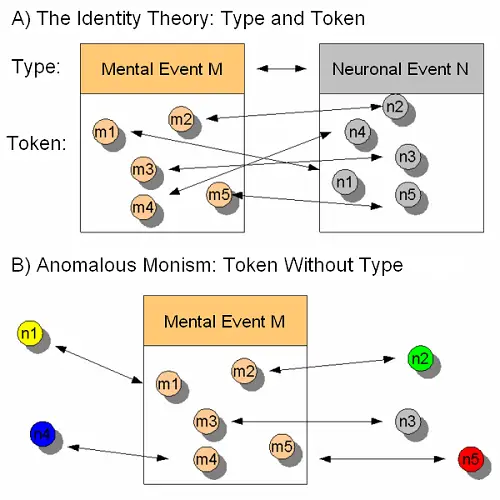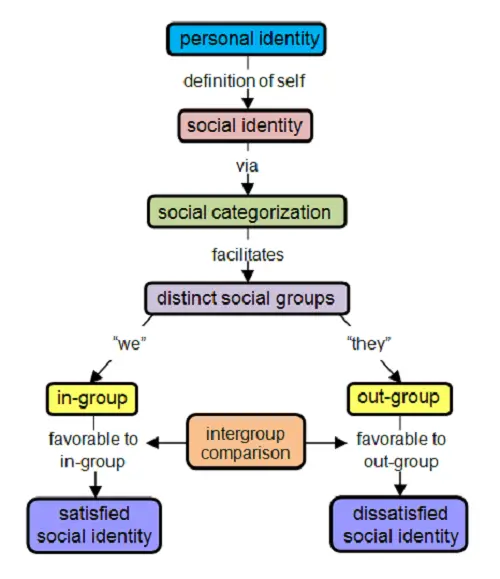
‘Identity theory’ or, more correctly, ‘identity theory of mind’, is a school of philosophical thought that maintains that ‘brain’ can be directly equated with ‘mind’ and that the two are essentially indistinguishable from each other. It says that for each and every ‘state of mind’ there is a unique and irreducible set of conditions that pertain to the brain. The relationship between brain and mind is held not to be just a set of correlations but different manifestations of the same thing. As with any branch of philosophical thought, positions vary with regard to the specificity of the mind-brain connectedness. ‘Type’ identity theory holds that the mind-brain relationship exists for different types of mental experience. ‘Token’ identity theory proposes instead that each mental state will have a very specific set of brain manifestations that limit the extent to which the identity between the two may be generalized.
Identity theory is a subdivision of the larger philosophical school known as reductive materialism. In such thinking, pre-eminence is given to material phenomena. That is to say, within this philosophical framework, even processes of complex abstract thought may ultimately be reduced to physical, identifiable and observable processes occurring in the brain.
Identity theory as a distinct sub-branch of reductive materialism had its heyday in the 1950s and early 1960s but does not have a particularly strong group of adherents today.
Social identity theory is centered on the idea that whichever groups you belong to in society play an important role in defining your sense of pride, your self-esteem, and your individual identity. Group membership may be ascribed by birth circumstances (like race, gender or religion), or may be chosen by the individual (like political party membership or preference for a particular golf club). Group membership may also be a formal one or an informal one; proper membership or perhaps just an infrequent association.
Social identity gives one a sense of belonging in society. Unfortunately, the individual’s notion of the ‘in-group’ –the group with which the individual most identifies- and his or her appraisal of that group, is also what gives rise to the ‘out-group’ and the attendant negative associations that pertain to this group. In other words, social identity can be a major source of prejudice and discrimination in society; those people or groups you identify with most are also likely to define those people or groups with whom you do not identify.

As a means of strengthening in-group identification, prejudices are often raised against members of the out-group/s. Most often, we inflate the positive characteristics of the in-group and deflate or diminish those same characteristics of the out-group. In doing this, there is a tendency to rely on stereotypes. A stereotype is the sum total of positive and negatives associations that pertain to any particular group, regardless of whether these are true or not. Stereotyping has the effect of simplifying one’s view of the world by ascribing social constructs and evaluations to groups. The effect of stereotyping is to strengthen notions of in- and out-group.
According to Tajfel and Turner (1979) there are three aspects to social identification:
- Social categorization
- Social identification
- Social comparison
We categorize people in order to make sense and understand our social environment. The stereotypes we hold allow us to go beyond what is immediately apparent and to generalize to other things that we believe to be true of the group. In the process of social identification one most often adopts the values and norms of the group we identify with. This identification has emotional weight attached to it; the identification seeks to make us feel better about ourselves. Finally, in the process of social comparison evaluations are made as to which attributes of the in-group and out-group are desirable or not. Those which are important and desirable will be magnified while those that are less desirable will be downplayed. With regard to the out-group, those characteristics of the group that are undesirable will be amplified and the desirable attributes will be, conversely, downplayed.
It is very difficult to draw comparisons between identity theory and social identity theory in that the two theories exist in different disciplines. Social identity theory certainly does not equate one’s individual identity directly with one’s social identity. The two would be considered to have very loose connections. Strong identification to in-groups would also not be expected to result in a sameness across members of that group except in the most general terms. However, one would expect that the more formal, rigid and disciplined the in-group membership, the more likely that the social identity is to conform across different individuals. The social identity of neo-Nazis is more likely to be similar and more clearly apparent than that of the neighborhood cake-baking collective.












Leave a Reply